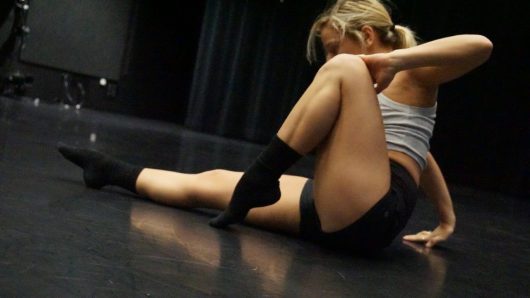
Liv Tschantz dances to her own choreography during her senior project audition for the Ohio
State Department of Dance, March 2017. Credit: Courtesy of Liv Tschantz
The children at Bridgeway Academy — a Columbus non-profit organization that focuses on meeting the educational and therapeutic needs of students with autism and other developmental disabilities — struggle with eye contact, social cues, loud music and spend most of their days sitting at their desks, said Liv Tschantz, a fourth-year in dance.
That changes on Mondays, though, when Tschantz visits the organization to teach the students how to dance.
“They’ll be standing there, doing nothing and the minute we put on Katy Perry, they just look at us and the eye contact they gave us with huge smiles on their faces — it’s unreal,” Tschantz said.
Tschantz’s experience working with children with developmental disabilities began when she was young when she used her lunch periods to read to them.
“It’s something my mom has always done, and she’s definitely been a positive force in guiding me to be passionate about that,” she said.
Now in her senior year at Ohio State, Tschantz has combined this passion with her other passion: dance.
Tschantz said some students in OSU’s Department of Dance choose to focus on performance or choreography in their senior projects.
“I decided on teaching dance in the community, my focus being on those with autism,” she said.
Every Monday, she and another dance student go to Bridgeway Academy, located just north of the University District, to teach dance to the students. Tschantz said they implement what they’ve learned during their years as dance students at OSU in their lessons with the kids.
“When we first started, we asked the director of Bridgeway what she wanted the students to work on,” she said. “She said she really wanted to see them move their legs and arms because all they do all day is sit. She said even if you can just get them to raise their hands above their heads, you don’t understand how much that’s going to change.”
Tschantz said she and her partner choreographed the warm-ups and dances based on what the director said they needed.
“Even if they’re not listening to our exact lessons and are just doing what they want to do with their bodies, it’s really awesome because they’re not really given that opportunity anywhere else,” she said.
Marisa Keels, a teacher’s aide at Haugland Learning Center, a Columbus school for children with developmental disabilities, said the dance lessons are a great way to increase hand-eye coordination, the ability to work in a group setting and sound tolerance.
“Throughout the day, we make sure the kids are constantly moving,” Keels said. “Getting them involved in movements that move the entire body can help them build friendships, as well.”
After the children grew familiar with Tschantz and her dance lessons, they began to pick up on the routine, make more eye contact and move a little more, Tschantz said.
“I think that’s what’s so exciting,” she said. “They don’t know their potential and they don’t even know what they’re capable of. It’s cool to see them have these self discoveries and watch them prove to themselves that they can do things that they didn’t think they could do before.”
Tschantz plans to continue her work next year with children with developmental disabilities at the Nisonger Center, a branch of the Ohio State Wexner Medical Center Neurological Institute that works to improve the lives of individuals with developmental disabilities. Her long-term goal however, is to open a wellness center of her own.
“I want to open a center that will allow me to implement dance as a wellness factor for those with autism, developmental disabilities like Parkinson’s and people who are quadriplegic and in wheelchairs,” she said. “I’ve had a lot of psychological and physical struggles myself and something that’s always kept me going is dance. So I want to be able to give what I’ve gotten.”


